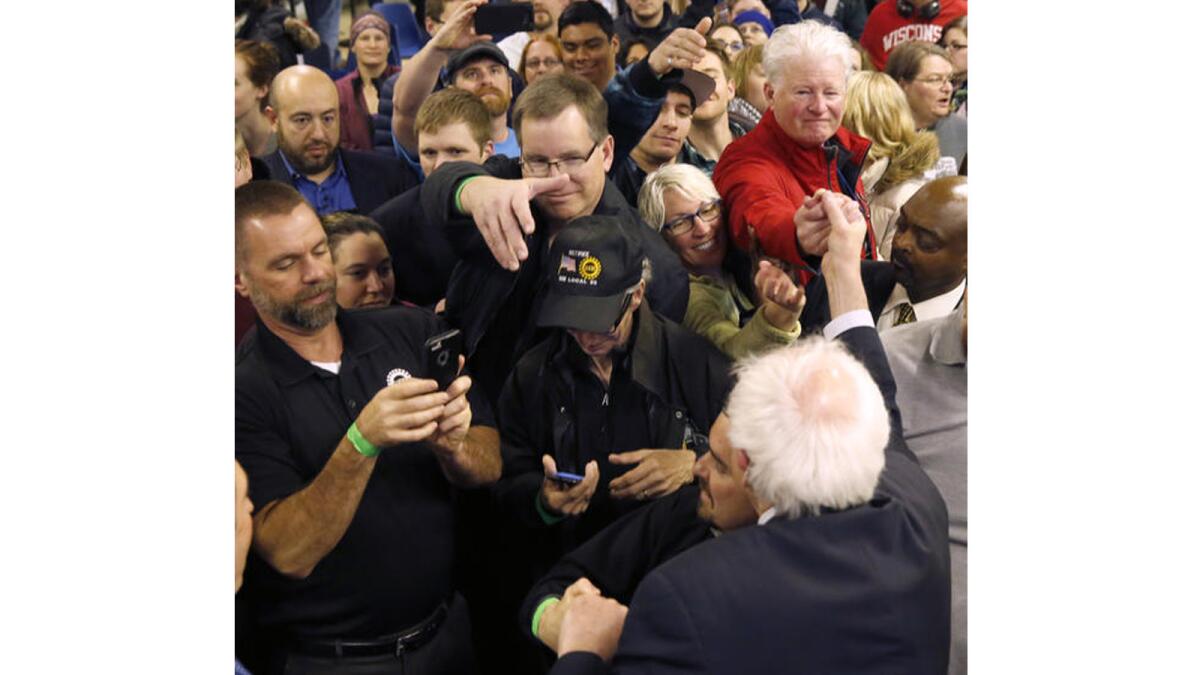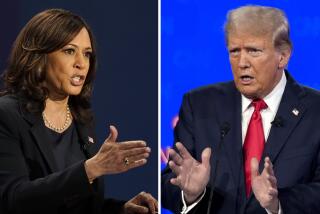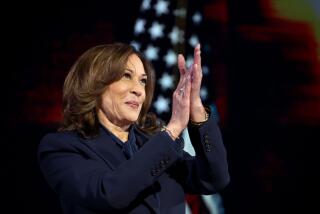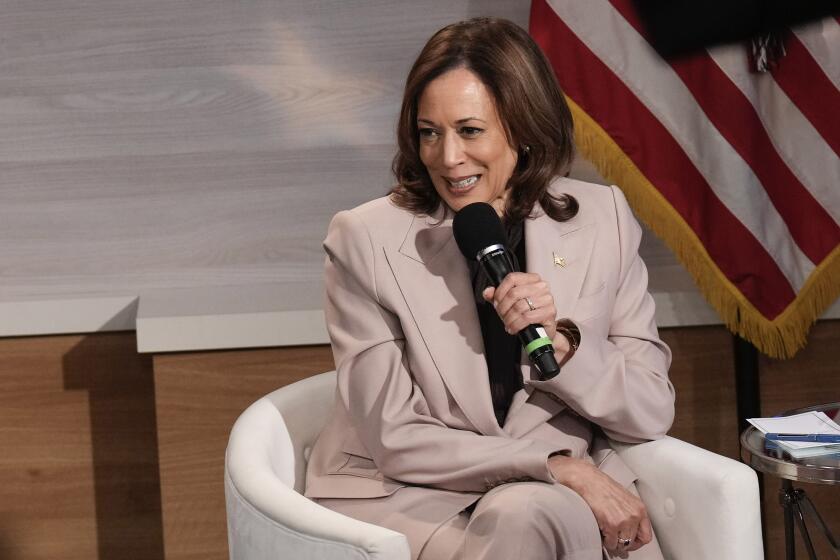‘Bernie blackout’ -- behind the numbers that have protesters in the streets

Democratic presidential candidate Sen. Bernie Sanders is mobbed by supporters at a rally at a union hall in Janesville, Wis., on April 4, 2016.
For years, it’s been an article of faith for Sen. Bernie Sanders that the media paid too much attention to trivial distractions and not enough to the issues he considers important.
Now, as the race for the Democratic presidential nomination moves into its final phase, with Sanders trailing Hillary Clinton, his backers have enthusiastically embraced a similar critique of the media.
Complaints about a “Bernie blackout” by news organizations have become a rallying cry for the campaign.
Do news organizations cover Sanders less than they should? The answer depends, of course, on what a person thinks the right amount should be.
Sanders and Clinton have received about the same level of coverage since the start of 2016. Both, however, receive much less media attention than Donald Trump, according to data on coverage by television and by media websites.
Sanders backers point to specific events in the campaign that they believe merited more attention. The Vermont senator’s victories in three western-state caucuses in late March, for example, received much less coverage than many Sanders backers thought they deserved.
Those sorts of slights, the critics say, stem from a premature judgment by media organizations that the Democratic race is, effectively, over and that Sanders has lost.
In the race for a majority of delegates to the Democratic convention in Philadelphia in July, Sanders has won 264 delegates fewer than Clinton in primaries or caucuses, according to the latest count by the Associated Press.
That does not include the roughly 470 party leaders and elected officials who automatically get to vote at the convention and who have indicated they will back the former secretary of State.
Sanders would have to win about 58% of the vote starting today in Wisconsin and extending through California on June 7 to overtake Clinton’s lead.
The belief that the media unfairly ignores Sanders has a lot of adherents in his camp. A poll in late March by the nonpartisan Pew Research Center found that 58% of Sanders supporters felt the media had given their candidate too little coverage.
By contrast, only 14% of Clinton supporters felt she was undercovered, with almost three-quarters feeling the volume of coverage was about right.
Of the five major candidates remaining in both parties, Ohio Gov. John Kasich was the only other one whose supporters felt the candidate wasn’t getting enough coverage.
John Paval, a 53-year-old communications consultant, was one of several Sanders supporters who recently wrote to The Times objecting to too little coverage of Sanders’ victories.
“Sanders wins by a much larger margin in Washington, the tenth most diverse state in the country, than Hillary did in Ohio, the tenth least diverse state in the country,” and journalists “draw the conclusion that Hillary has proven her strength in diverse states but Sanders hasn’t,” he wrote.
The charges of under-coverage date back to at least December. In a statement early that month headlined “Why the Bernie Blackout on corporate network news?”, Sanders campaign manager Jeff Weaver said that the “corporately-owned media may not like Bernie’s anti-establishment views,” but news organizations “must allow for a fair debate in this presidential campaign.”
Weaver’s language points to one of the ways that accusations of under-coverage can help the Sanders campaign.
As a self-styled insurgent, Sanders has defined himself as a a truth-telling critic of the corporate establishment. The accusations about coverage bolster that central campaign narrative.
Since December, however, three things have happened: Sanders has begun winning primaries and caucuses, he’s gotten more coverage and many of his supporters have shifted from complaints about too much focus on Trump to the charge that the media gives Sanders less attention than Clinton.
Over the weekend, a group of Sanders supporters picketed the CNN building in Hollywood to highlight their complaint about the volume of coverage. Some carried signs calling the cable news station the “Clinton News Network.”
Sanders did receive less coverage than Clinton in 2015. At the time, he had not yet won anything, and she was receiving intense media scrutiny over her use of a private server to handle email while she was secretary of State and over Republican accusations that she acted wrongly in connection with the deaths of four Americans in the attack on the U.S. diplomatic compound in Benghazi, Libya, in 2012.
Since the start of this year, the two have received very similar amounts of coverage, according to data from the Internet Archive’s presidential tracker project, which logs all candidate mentions on news shows and a variety of other programs. Each currently accounts for about 15% of all mentions of a candidate on TV, the tracking data indicate.
Another study, by researchers at the USC Annenberg Center on Communication Leadership and Policy, also found rough parity between the two.
Ev Boyle, the associate director of the center, and a group of researchers spent a week counting every mention of a candidate on 14 major news websites, including latimes.com.
“The Bernie Blackout isn’t really a thing,” Boyle concluded, noting that Sanders had close to the same level of coverage as Clinton, although both were far behind Trump.
All the attention to the volume of attention implies, of course, that more coverage is always good for a campaign. That’s seldom actually true, as the scrutiny of Clinton’s email demonstrates.
Trump’s coverage provides another object lesson. Since he entered the presidential race last July, the New York businessman has dominated news coverage, as well as Google searches, social media and virtually every other measure of attention.
Since early February, he has accounted for roughly half of all candidate mentions on television, the Internet tracking project found.
The disproportionate coverage almost certainly helped propel Trump to the front of the GOP field early on. He has gotten publicity for his statements that would have cost hundreds of millions of dollars to buy through advertising.
All that attention may have caught up to Trump, however. The coverage has also highlighted his often-insulting comments about women, minorities and his rivals, and the violence that has surrounded some Trump rallies. That has helped push his public image to a low point not seen in a major political candidate in three decades.
For more on Campaign 2016, follow @DavidLauter
ALSO
Will Wisconsin slow Trump’s march to the White House? Five things to watch in tonight’s primary
On a big day for minimum wage hikes, Clinton grabs the spotlight
Bill Clinton, star surrogate and reminder of Hillary Clinton’s liabilities
More to Read
Get the L.A. Times Politics newsletter
Deeply reported insights into legislation, politics and policy from Sacramento, Washington and beyond. In your inbox three times per week.
You may occasionally receive promotional content from the Los Angeles Times.











